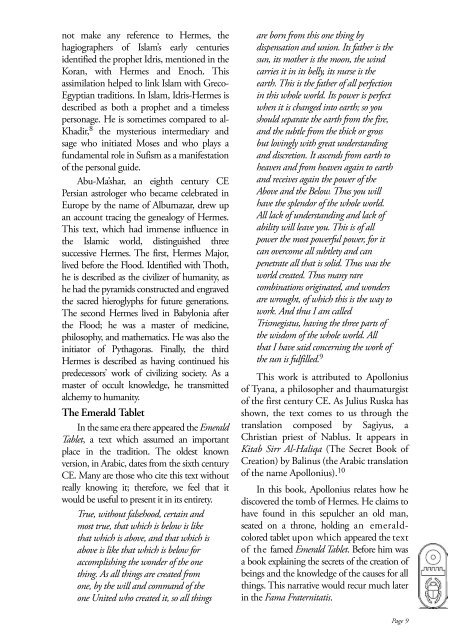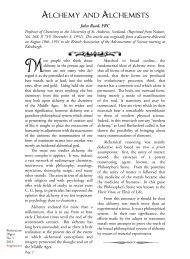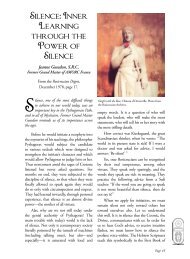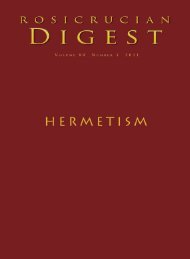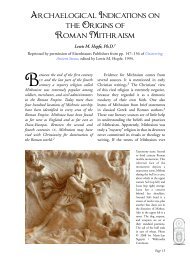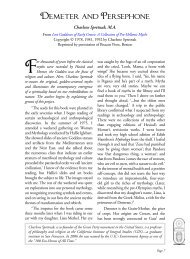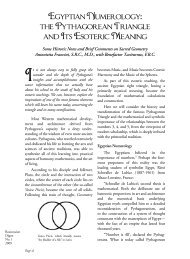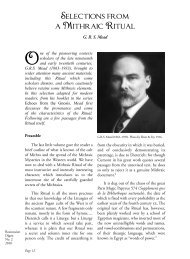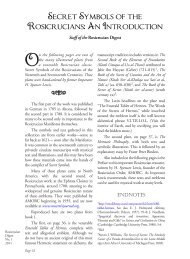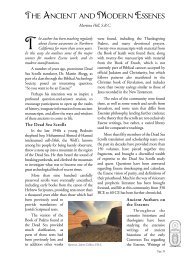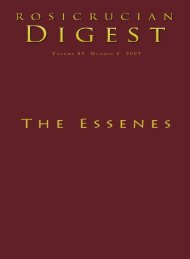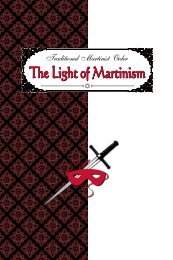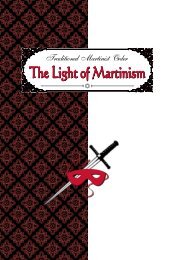Digest - Rosicrucian Order
Digest - Rosicrucian Order
Digest - Rosicrucian Order
You also want an ePaper? Increase the reach of your titles
YUMPU automatically turns print PDFs into web optimized ePapers that Google loves.
not make any reference to Hermes, the<br />
hagiographers of Islam’s early centuries<br />
identified the prophet Idris, mentioned in the<br />
Koran, with Hermes and Enoch. This<br />
assimilation helped to link Islam with Greco-<br />
Egyptian traditions. In Islam, Idris-Hermes is<br />
described as both a prophet and a timeless<br />
personage. He is sometimes compared to al-<br />
Khadir, 8 the mysterious intermediary and<br />
sage who initiated Moses and who plays a<br />
fundamental role in Sufism as a manifestation<br />
of the personal guide.<br />
Abu-Ma’shar, an eighth century CE<br />
Persian astrologer who became celebrated in<br />
Europe by the name of Albumazar, drew up<br />
an account tracing the genealogy of Hermes.<br />
This text, which had immense influence in<br />
the Islamic world, distinguished three<br />
successive Hermes. The first, Hermes Major,<br />
lived before the Flood. Identified with Thoth,<br />
he is described as the civilizer of humanity, as<br />
he had the pyramids constructed and engraved<br />
the sacred hieroglyphs for future generations.<br />
The second Hermes lived in Babylonia after<br />
the Flood; he was a master of medicine,<br />
philosophy, and mathematics. He was also the<br />
initiator of Pythagoras. Finally, the third<br />
Hermes is described as having continued his<br />
predecessors’ work of civilizing society. As a<br />
master of occult knowledge, he transmitted<br />
alchemy to humanity.<br />
The Emerald Tablet<br />
In the same era there appeared the Emerald<br />
Tablet, a text which assumed an important<br />
place in the tradition. The oldest known<br />
version, in Arabic, dates from the sixth century<br />
CE. Many are those who cite this text without<br />
really knowing it; therefore, we feel that it<br />
would be useful to present it in its entirety.<br />
True, without falsehood, certain and<br />
most true, that which is below is like<br />
that which is above, and that which is<br />
above is like that which is below for<br />
accomplishing the wonder of the one<br />
thing. As all things are created from<br />
one, by the will and command of the<br />
one United who created it, so all things<br />
are born from this one thing by<br />
dispensation and union. Its father is the<br />
sun, its mother is the moon, the wind<br />
carries it in its belly, its nurse is the<br />
earth. This is the father of all perfection<br />
in this whole world. Its power is perfect<br />
when it is changed into earth; so you<br />
should separate the earth from the fire,<br />
and the subtle from the thick or gross<br />
but lovingly with great understanding<br />
and discretion. It ascends from earth to<br />
heaven and from heaven again to earth<br />
and receives again the power of the<br />
Above and the Below. Thus you will<br />
have the splendor of the whole world.<br />
All lack of understanding and lack of<br />
ability will leave you. This is of all<br />
power the most powerful power, for it<br />
can overcome all subtlety and can<br />
penetrate all that is solid. Thus was the<br />
world created. Thus many rare<br />
combinations originated, and wonders<br />
are wrought, of which this is the way to<br />
work. And thus I am called<br />
Trismegistus, having the three parts of<br />
the wisdom of the whole world. All<br />
that I have said concerning the work of<br />
the sun is fulfilled. 9<br />
This work is attributed to Apollonius<br />
of Tyana, a philosopher and thaumaturgist<br />
of the first century CE. As Julius Ruska has<br />
shown, the text comes to us through the<br />
translation composed by Sagiyus, a<br />
Christian priest of Nablus. It appears in<br />
Kitab Sirr Al-Haliqa (The Secret Book of<br />
Creation) by Balinus (the Arabic translation<br />
of the name Apollonius). 10<br />
In this book, Apollonius relates how he<br />
discovered the tomb of Hermes. He claims to<br />
have found in this sepulcher an old man,<br />
seated on a throne, holding an emeraldcolored<br />
tablet upon which appeared the text<br />
of the famed Emerald Tablet. Before him was<br />
a book explaining the secrets of the creation of<br />
beings and the knowledge of the causes for all<br />
things. This narrative would recur much later<br />
in the Fama Fraternitatis.<br />
Page 9


